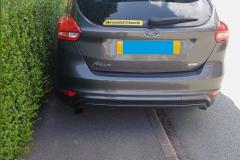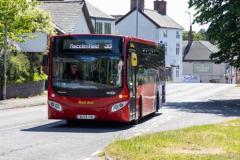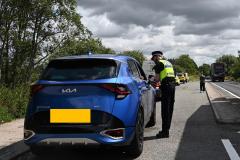Cheshire East Council is proposing to reduce the number of roads that get gritted each winter, including several of the main routes in Alderley Edge.
The routes currently treated by the Council date back to the days of Cheshire County Council and at present, the Council treats around 1120km of the 2700km network (41%).
The Council has carried out a risk assessment process, which has identified 995km out of 2700km (37%) highway network as requiring routine winter treatment.
As a result, the proposal to be considered by the Cabinet on Tuesday, 4th February is for 103km of previously untreated roads to be added to the network. 892 km of previously treated roads remaining on the network and 230km of previously treated roads removed from the treated network.
Roads recommended for removal are in Handforth, Lacey Green, Wilmslow Park and Morley Green along with Chorley Hall Lane, Mottram Road, Heyes Lane and Trafford Road in Alderley Edge. Whilst there are roads added to the route in the town centre, Pownall Park, Handforth and Styal.
Where roads are removed from the treated network, a grit bin risk assessment will be undertaken to ascertain if a grit bin is required.
Considering the risks of implementing these changes the report states "The removal of some roads from the winter treatment network could increase the risk of accidents on the network; however, the risk assessment process adopted should mean this is a manageable risk.
"The removal of some of the rural roads may make access to some rural businesses and communities difficult during snow and icing conditions; however, the proposed assessment of the removed roads for a grit bin could help to mitigate this."
The Council also has cross boundary agreements where roads in other council's areas are treated in return for the treatment of roads in Cheshire East to deliver route efficiencies. The Council presently treats 58km of other councils' roads with 19km of the CEC network treated in return. These cross boundary routes will be reviewed and dialog has begun with the neighbouring authorities to discuss changes.
Cheshire East is also proposing to amend the current frequency of safety inspections so that 843km of the most heavily trafficked roads in the Borough receive an increase in inspection frequency and 516km of lesser used routes receiving a lower inspection frequency. Under the proposals, the roads considered most important would receive inspections every month, whereas under the existing arrangements this is undertaken every two months.
Another proposal being considered is revising the response times for the repair of defects. The current code of practice, aims to address the most dangerous actionable defects within 1.5 hours and less dangerous actionable defects within 5 days. The proposal is to address emergency defects in 1 hour during the working day and 1.5 hours outside of working hours; however, defects that pose a lesser risk to the traveling public will be repaired between 2 and 20 working days from the point of identification by an inspector.
Additionally the Council is proposing to change the approach to road defects from intervention levels to investigatory levels. Under the current approach defects are actioned at the specific intervention level: 50mm for potholes, 100mm for carriageway edge deterioration, 25mm cycle-path or footpath defect and 50mm for cycle lane defects. Under the proposed approach defects are risk assessed at the investigatory level to determine the risk they pose to the public: 40mm for potholes, 80mm for carriageway edge deterioration, 20mm cycle-path or footpath defect and 20mm for cycle lane defects.
What do you think about the above proposals? Share your views via the comment box below.
Maps showing proposals
Green - road to remain on route.
Orange - road to be removed.
Blue - road to be added.












Comments
Here's what readers have had to say so far. Why not add your thoughts below.
(1) Lacey Green itself is a fairly long, straight road and has a real problem with speeding cars. It also exits onto other busy roads at each end.
(2) This is a heavy volume area. Lacey Green is heavily used by drivers approaching Wilmslow from Stanneylands/Styal (which is now often the only way into Wilmslow from Stanneylands/Styal with Twinnies Bridge now consistently out of action during wet weather).
(3) Barlow Road and Twinnies Road are the only two roads into Lacey Green Primary Academy. Removing the service is a real risk to children heading to/from school.
(4) I hardly think these roads can be classified as "rural" roads. I struggle to think of any other areas in the vicinity which are more urban.
They’ll be firing up the “lessons have been learned” generator very soon.
The Morley Green to Mobberley road is a significant commuting route for many, including cyclists, and including sections with steep gradients and tight bends which will be a massive hazard if not gritted.
As the temperature was just about freezing, the un-treated pavements and roads were like a skating rink and I trod ginger. So much so, that I got as far as Wilmslow Station where I had to take a taxi the rest of the journey.
I'm used to seeing roads on Summerfields left un-treated - but to expand that is an extraordinary idea.
The Department for Transport requires all councils to manage their local highways using their prescribed formula. Each road is given a score depending on factors such as the category of road, volume of traffic, types of vehicles, history of accidents, connectivity with principal routes, whether schools are present and if it has a bus route. This score then decides if the road gets gritted or not. These proposed changes are based on the results of this assessment.
So why have we had to do this assessment? Well over the last 5 years, the Department for Transport has given £12m each year to Cheshire East Council to help maintain its roads (such as temporary repairs, patching, resurfacing etc). However, this funding will only continue if Cheshire East introduces the above criteria for winter maintenance.
So we have a choice. Either accept reductions in the winter service programme and keep this £12m for road maintenance or else continue the existing gritter routes but lose the money. It’s a no win situation.
However, just to be clear that this does not mean these roads will never be gritted. It just means they will not be on the route for pre-emptive gritting. However, in extreme weather conditions additional resources are then employed by the council, which means they will still be treated.
I therefore hope this helps everyone understand why this has happened and that it's not something Cheshire East wanted to undertake.
Best regards
Cllr Mark Goldsmith
Residents of Wilmslow, Cheshire East
Thank you for your post, but it seems to raise more questions than answers as to the appropriateness of the current proposals.
My opinion is that there appears to be some sense in some of the proposals but not in every area. And there appear to be some major omissions relating to access routes to all schools.
I have sent you and your fellow councillors for the Wilmslow and Handforth Wards an email containing detailed comments.
Despite the fact he Handforth Dean free bus service still uses some of these roads - I look forward to the chaos of this service attempting to get up the un-gritted inclines on Barlow and Twinnies roads - the council in their infinite wisdom have decided to not grit the only access roads for the primary school - which probably does not affect many of the 'Wilmslow Tractor' SUV drivers, but will hugely increase the danger to pedestrians (Lacey Green Residents suffer again) at morning and afternoon drop off/collection times.
How many children have to be injured or - god forbid killed - before CEC realises the stupidity of not gritting roads with inclines leading to a primary school.
Ludicrous ideas.
To Cllr Mark Goldsmith "So we have a choice. Either accept reductions in the winter service programme and keep this £12m for road maintenance" and put childrens lives at risk as they attempt to get to and from school........ "or else continue the existing gritter routes but lose the money." but increase child safety.
Lets see, money or childrens safety......... hmmmm tough one!
Just to reiterate, this criteria from the Department for Transport is used across the whole of the UK to decide what roads are gritted. It is not an arbitrary decision by Cheshire East.
Many roads in Wilmslow that have a primary school on them have NOT been gritted for the past 20 years I have lived here. Nor will they be gritted under this new formula. Therefore, while I understand your frustration Paul, using the lives of school children as emotional blackmail is completely inappropriate.
Having a primary school on a road is not a guarantee that it is gritted as other factors are also needed. Perhaps this is because these roads are only busy during school drop-off and pick-up times. Or because schools are closed during extreme weather. Or because schools are only open 185 days of the year, so there is a 50% chance the gritting will be pointless.
Regardless of the reasons though, this is a UK wide formula that is designed to ensure councils focus their spending on the roads that will maximise safety. We cannot grit all the roads, so we have to prioritise. Using a logical system to do this seems a far better way to do it though than one based on who complains the loudest.
Having previously worked in a greater London Council planning department for over 18 months, I understand completely how the calculations SHOULD be carried out and it is not emotional blackmail, but a genuine concern at a further erosion of public services for the Lacey Green estate.
By your Logic above, there is simply no reason why the road to Pownall Park School should be added to the gritting (no through road, no Bus service and crucially to the formula, no inclines or hills), while Lacey green loses its despite having all 3 of these conditions. I can well understand removing the gritter over part of this route that no longer has a bus service on it, but to remove it from Twinnies Road, and Barlow Road - which the free bus uses 6 times a day, 3 days a week - and are the access roads to local shops, as well as the school. In addition, almost all traffic heading into the rest of the estate uses the cross roads at twinnies (containing local shops)/Barlow/Cranford/Holly Bank (including the school) roads so it is not just busy "185 days" or only at "school drop-off and pick-up times" but at all times.
I fail to see how your 'Nationally used criteria' results in the removal of Lacey green gritting but ADDS gritting to Pownall Park - which already contains traffic calming measures to discourage drivers using this as a rat run and slows cars down, I would be keen to see your justification of these two decisions side by side. It is clearly a decision by CEC and does not apply the correct National formula in these two cases.
Many of the other roads outside primary schools in the Wilmslow area are, as you rightly say not all gritted - this is generally because these schools are in low density traffic areas, away from main routes and do not require bus access (not that there is very much bus access anywhere in Wilmslow these days - but that is another issue) and do not have hills / inclines or other local services such as shops, causing an increased hazard - particularly to the local pedestrian users.
As one of our local representatives, Mark, it does not help the debate to confuse genuine hazard concern and mitigation with 'emotional blackmail'.
A recording of the debate can be listened to at:
https://bit.ly/2OsNTLZ
The key point raised at today's meeting is that Cheshire East will show on their web site the risk criteria used and the score each road achieved. Therefore, people can see why these decisions have been made and to challenge them if there are any clear errors.
There will be no immediate change to the gritting routes though as these proposals are not due to be implemented until next winter.